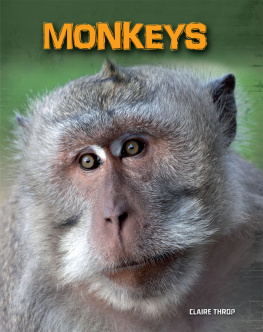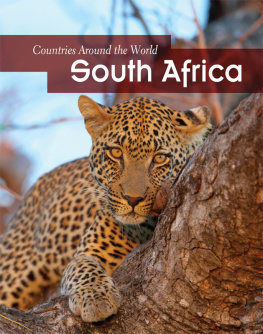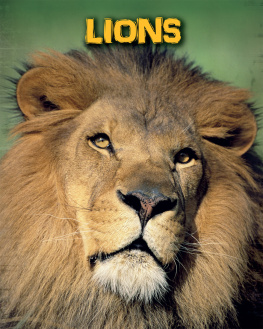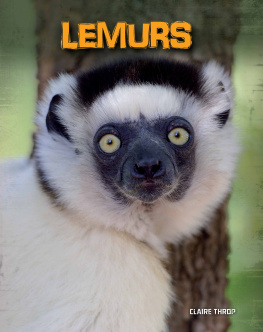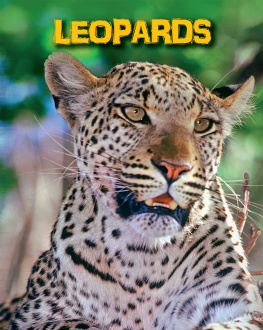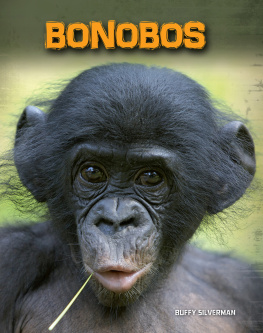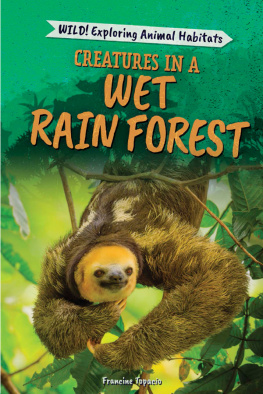Glossary
adaptation body part or behavior of a living thing that helps it survive in a particularhabitat
classify group living things together by their similarities and differences
conservation protection or restoration of wildlife and the natural environment
conserve protect from harm or destruction
dominant strongest; most powerful
eco-tourism form of tourism that allows people to observe wildlife and help protectnature
endangered living thing that is at risk of dying out
evolve change gradually over time
extinct living thing that has died out
extinction when a living thing has died out
forage look for food over a wide area
habitat natural environment of a living thing
mammal animal that has fur or hair, gives birth to live young, and feeds its youngon milk from the mother
nutrient substance that provides a living thing with the nourishment it needs togrow and live
opposable thumb thumb that can face and touch the fingers on the same hand
rain forest forest with tall, thickly growing trees in an area with high rainfall
reintroduce put a living thing back into its natural environment
species group of similar living things that can mate with each other
subtropical regions of Earth that border the tropics
territory area of land that an animal claims as its own
tropical regions of Earth around the equator
Find Out More
Books
de la Bedoyere, Camilla. 100 Things You Should Know About Monkeys and Apes . New York:Barnes and Noble, 2008.
Moore, Heidi. Protecting Food Chains: Rain Forest Food Chains . Chicago: HeinemannLibrary, 2011.
Solway, Andrew. Classifying Living Things: Classifying Mammals . Chicago: HeinemannLibrary, 2009.
Websites
http://animals.nationalgeographic.com/animals/photos/monkeys/
This website has lotsof pictures of different species of monkeys.
www.sandiegozoo.org/animalbytes/t-monkey.html
Learn more about monkeys at this website.
Organizations to contact
World Wildlife Fund
www.wwf.org
WWF works to protect animals and nature, and it needs your help! Take a look at itswebsite to see what you can do.
Endangered Species International
www.endangeredspeciesinternational.org/index.php
This organization focuses on saving endangered animals around the world.
Born Free USA Primate Sanctuary
www.bornfreeusa.org/sanctuary/
This organization provides a sanctuary for baboons, macaques, and vervets, many ofwhich come from abusive situations.
What Are Primates?
What is that noise? Its deafening! Up in the trees above sits a howler monkey callingto let others know where the group is feeding. His call can be heard up to 3 miles(5 kilometers) away.
There are more than 350 species of primate, and these include monkeysand humans!Our closest relatives are apes and monkeys. We are alike in many ways. Primates are mammals . This means they have hair or fur on their bodies and produce milk for theirbabies to drink.
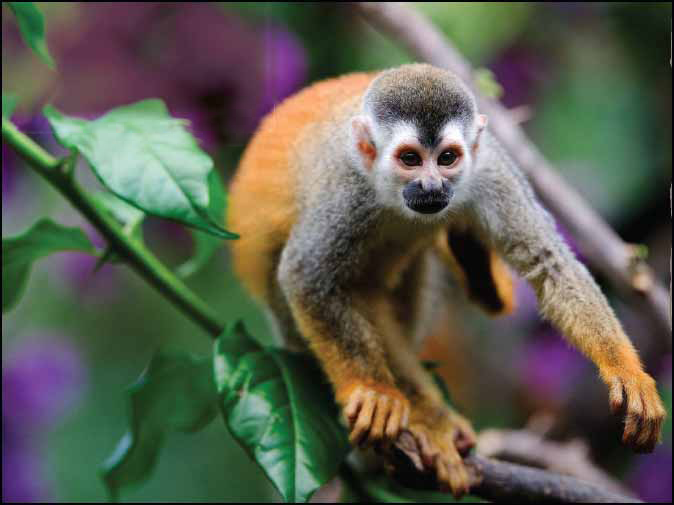
This squirrel monkey is a primate. It is intelligent, likes to live in groups, andhas eyes at the front of its head, just as humans do.
Common features
Primates have many things in common. They are mainly arboreal (live in trees). Theyare intelligent, which means they can think about problems and try to solve them.They can learn new skills and pass them on to infants. They also share a desire tobe social (to live with others). Many species of primate live in large groups calledtroops.
Endangered
One thing nearly all primates have in common is that they are endangered . In manycases, the threats come from humans. Habitat destruction and hunting are just twoof the problems faced by primates.
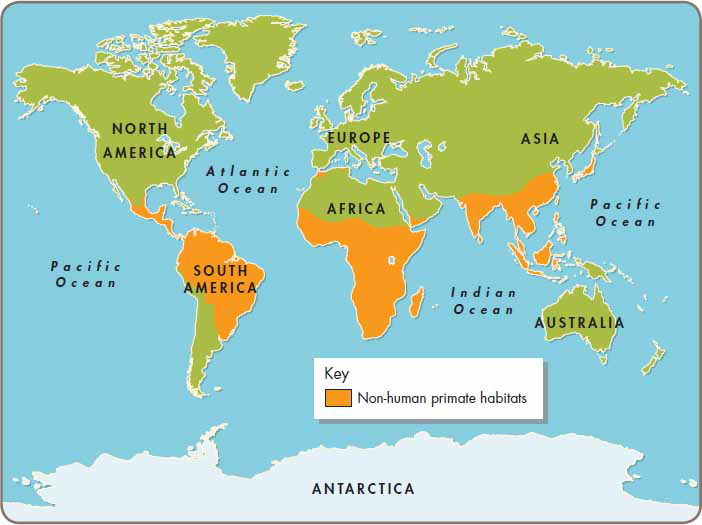
This map shows where in the world non-human primates live.
What Are Monkeys?
There are over 250 species of monkey, which are divided into Old World monkeys andNew World monkeys. About 30 million years ago, some Old World monkeys moved acrossthe Atlantic Ocean from Africa to South America, perhaps on floating tree trunksor vegetation (plant life). Over a long period of time, the monkeys evolved and becamewhat we today call New World monkeys.
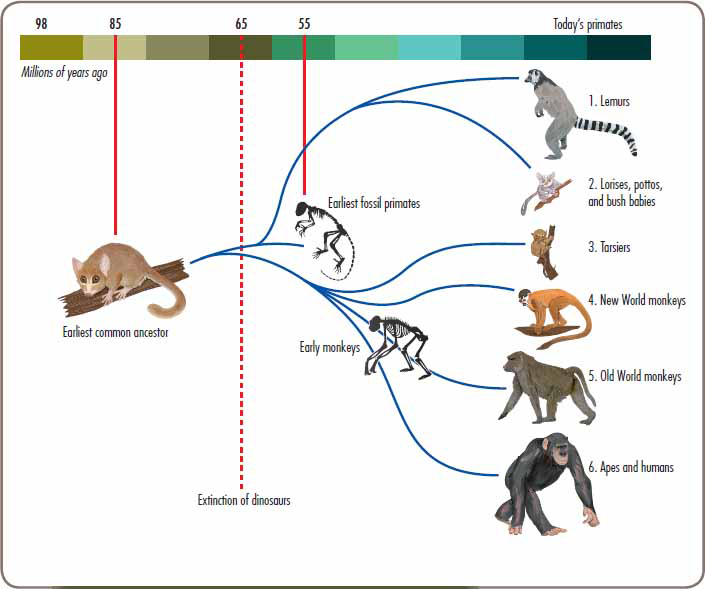
This diagram shows how early primates evolved into lemurs, monkeys, apes, and humans.
Monkey features
One way of telling whether a monkey is Old World or New World is by its tail. NewWorld monkeys tend to spend a lot of time in trees, so most of them have prehensiletails. Prehensile means able to grasp. The monkeys can use their tails to holdonto branches as they move. Old World monkeys do not have prehensile tails. SomeOld World monkeys live on the ground. They have bare sitting pads on their rear ends.New World monkeys do not have these pads.
Most monkeys have flat faces. Old World monkeys have large noses and forward- anddownward-pointing nostrils. Most of them also have cheek pouches in which they canstore food. New World monkeys have flatter noses with wider-set, sideways-facingnostrils.
Monkeys have hands that are very like humans hands. They can grab, hold, and pokethings. Old World monkeys have opposable thumbs , which make it easy for them to holdthings.
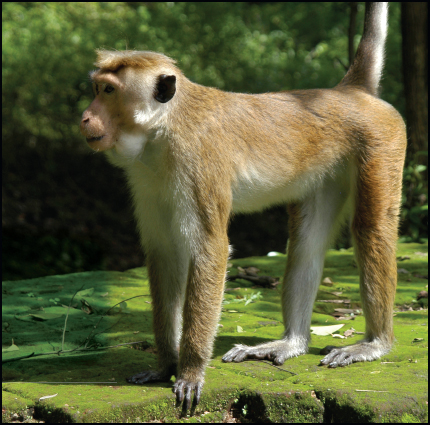
This is a toque macaque, a type of Old World monkey.
How Are Monkeys Classified?
Classifying things is the way that humans try to make sense of the living world.Grouping living things together by the characteristics that they share allows usto identify them and understand why they live where they do and behave as they do.
Classification groups
The standard animal groups are kingdom, phylum, class, order, family, genus, and species . Sometimes, further classification involves adding more groups, such as asuborder or parvorder.
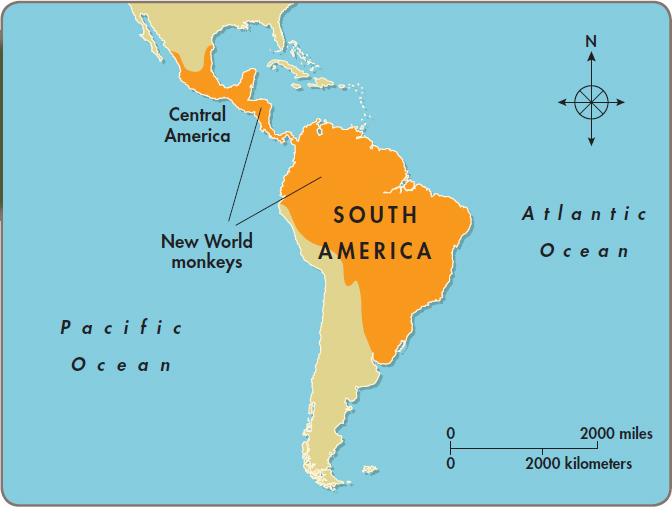
New World monkeys live in South and Central America.
Each of the standard groups contains fewer and fewer members. So, there are moreanimals in the class Mammalia ( mammals ) than in the genus Saimiri (squirrel monkeys).Animals are given an internationally recognized two-part Latin name. This helps toavoid confusion if animals are known by different common names in different countries.For example, the rhesus monkey has the Latin name Macaca mulatta .
New World monkeys
Haplorrhini (monkeys, apes, and tarsiers) is a suborder of primates. The suborderincludes two parvorders: Platyrrhini (New World monkeys) and Catarrhini (Old Worldmonkeys). Platyrrhini means flat noses. Originally, New World monkeys were groupedinto only two families. Recently, more families have been added. Not all scientistsagree on the number of families. Some list four, while others list five.

